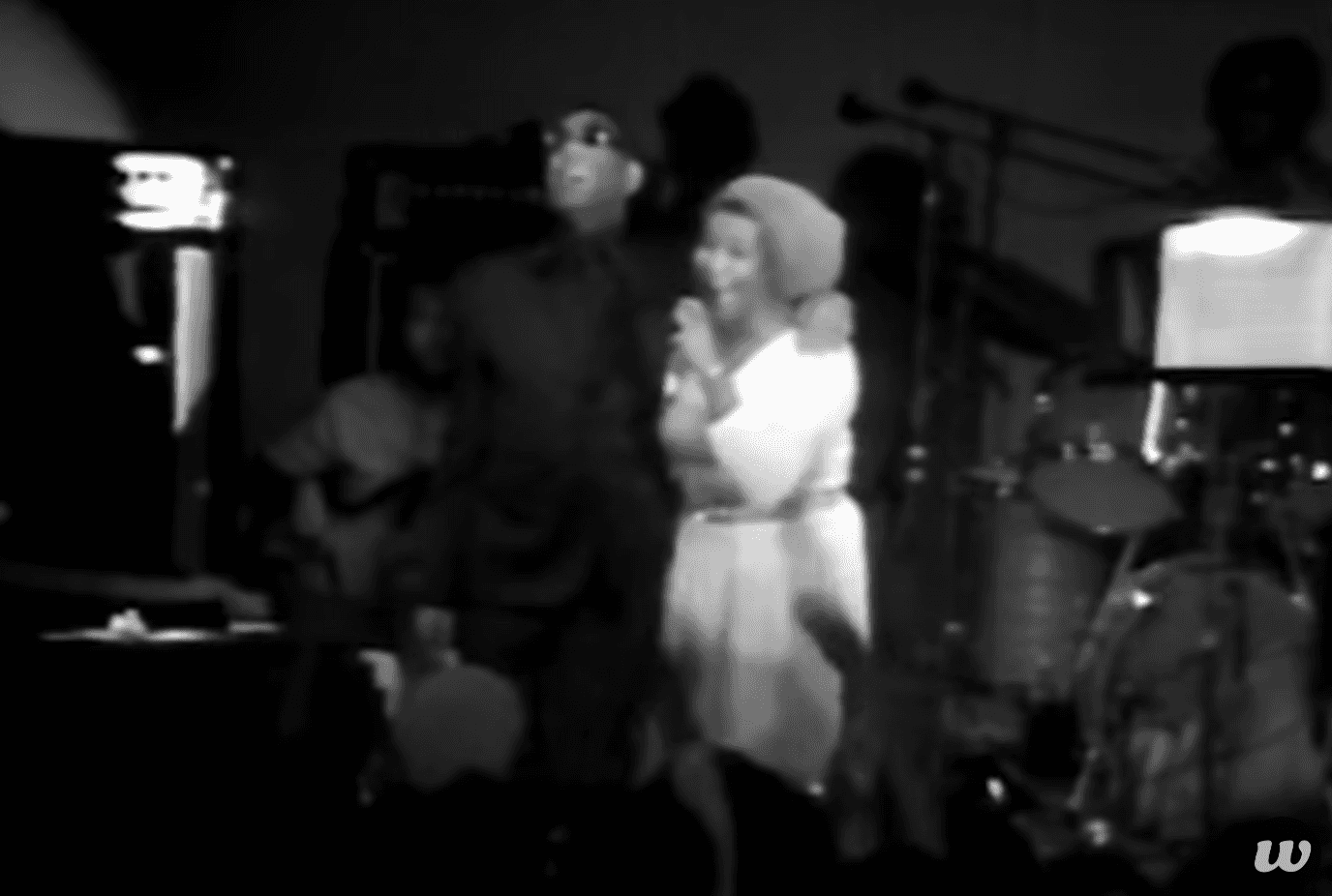Blurred Lines: Holy | Profane
For many African American artists, especially vocalists and musicians, their artistic productions often blur and transgress the boundaries between the holy and the profane. While historically Black sacred music is performed within ritual religious contexts—churches, mosques, temples, synagogues, and other spaces consecrated as holy—these artists often transport the power of Black sacred music into secular or profane spheres, fusing modalities and moving back and forth between genres. At times, the spheres mutually influence, inform, and enrich each other, be it sonically, lyrically, or instrumentally, further complicating the relationship and intersection of these distinctive genres.

I think God is inside everybody.
Prince, Ebony Magazine interview, 1986
Aretha Franklin
Aretha Franklin performing at Arie Crown Theater, Chicago, Illinois, 1985; photo by Vandell Cobb (b. 1946)
Aretha Franklin, Amazing Grace, Atlantic Records, 1972
One of the greatest musical talents of the 20th century, Aretha Franklin (1942–2018) is widely regarded as the Queen of Soul. Beginning her musical career in her father’s church, she was severely criticized by the church for her highly public secular singing career. Though she never considered herself to have left the church, Franklin, in a comment made in Jet in 1970, explained that both secular and religious music emerge from the depths of the Black spirit. In 1972, at the height of her secular career, she produced the best-selling live gospel album of all time—Amazing Grace—forever transgressing the boundaries between the sacred and the secular.

Featured Video
Aretha Franklin performing “Spirit in the Dark”
In a 1971 Ebony interview, Rev. Cecil Franklin was asked to explain his sister Aretha’s power to move audiences with songs like “Spirit in the Dark.” Franklin replied: “It’s a combination of electricity and empathy. . . . She does with her voice exactly what a preacher does with his when he moans to a congregation.”
Experience Aretha Franklin perform “Spirit in the Dark” at Fillmore West in San Francisco, California, on March 3, 1971.

Nina Simone & Sam Cooke
Nina Simone singing “I Loves You Porgy” from Porgy and Bess at Midtown Bar, Atlantic City, New Jersey, 1959; photo by G. Marshall Wilson (1905–1998)
Sam Cooke, 1958; photo by G. Marshall Wilson (1905–1998)
Through their distinctive and sensational performance styles, Nina Simone (1933–2003) and Sam Cooke (1931–1964) brought sounds of the sacred and the soulful into American popular culture. Both children of pastors, even while singing secular songs they each evoked religious symbolic expression in tunes such as Simone’s “Sinnerman” and Cooke’s “A Change Is Gonna Come.” Both also endured personal tragedies that inspired them to use their unique musical forms to speak about the everyday traumas in Black America. Their music exemplified the fusion of gospel and rhythm and blues, what Negro Digest described in 1966 as the “the big beat” mixed with “the cries and humming of the spirituals.”
Marvin Gaye
Marvin Gaye performing at Capital Centre, Landover, Maryland, August 1974; photo by G. Marshall Wilson (1905–1998)
Marvin Gaye, What’s Going On, Tamla Records, 1971
Described in a 1974 Ebony article as “intensely spiritual, almost mystical,” and seemingly in “pursuit of some ethereal other-world” because of his preoccupation with religion and sexuality, Marvin Gaye’s (1939–1984) artistry further complicated conventional notions of the holy and the profane. The son of a Hebrew Pentecostal minister, it was the Pentecostal Church that served as the context of his faith formation and creative musical genius. A major artist on the Motown label, Gaye is credited as one of the sonic architects responsible for creating Motown’s distinctive sound. A musical prodigy, in addition to excelling lyrically and vocally, he became a multi-instrumentalist, mastering keyboards and percussion instruments.

Prince
Prince, Controversy, Warner Bros. Records Inc., 1981
As a youth watching his church musician father perform in jazz clubs, Prince Rogers Nelson (1958–2016) was mesmerized by music experienced in both sacred and secular spaces. His religious formation took place over time and in diverse communities, including the Pentecostal Church (where his father played), the Seventh-Day Adventist Church, and in his later years, as a Jehovah’s Witness. In 1984, Ebony associate editor Lynn Norment noted that Prince, whom friends described as “very religious,” had written “some of the most sexually explosive lyrics to hit the airwaves.” Prince’s life and music embraced a theology of transcendence that encompassed the erotic and the religious, demanding that boundaries defining both be re-examined.

Prince during the Purple Rain Tour, 1984; photo by D. Michael Cheers (b. 1953)
Prince performing at First Avenue during the Parade Tour, Minneapolis, Minnesota, March 3, 1986; photo by James L. Mitchell (1946–2022)
Amiri Baraka
Amiri and Amina Baraka at home with their children, Newark, New Jersey, 1969; photo by Moneta Sleet Jr. (1926–1996)
“Black Theatre for the Black Panthers” benefit poster, Radical Theatre Repertory, May 20, 1968
The assassination of Malcolm X in 1965 changed writer LeRoi Jones (1934–2014). In 1967, Jones converted to Kawaida, embracing a form of African spirituality tied to Black Nationalism and progressive social thought. Becoming an imam within this tradition, he adopted the name Imamu Amiri Baraka. He told Negro Digest in a 1969 interview that Islam was the source of Black art, and the purpose of art was “to collect that Divinity, to show its existence, to praise it.” However, by 1974 Baraka began to distance himself from Black Nationalism and dropped Imamu, a title meaning “spiritual leader” in Swahili. He then identified as a Marxist-Leninist-Maoist, attaching himself to communist ideologies that completely reject religion.

James Brown
James Brown performing at President Richard Nixon’s Inaugural Ball Gala at the National Guard Armory, Washington, D.C., 1969; photo by Moneta Sleet Jr. (1926–1996)
Known as the Godfather of Soul, James Brown (1933–2006) laid the groundwork for the American musical traditions of soul and funk. Early inspired by the percussive spirituality of the Black church, Brown became a boy preacher and quartet singer in his youth. The power and ritual forms of preaching and gospel-singing served as fonts for his secular musical success. His music provided the soundtrack and articulation for the resurgence of Black pride that inspired Black people in the late 1960s and early 1970s.
Al Green
Al Green, 1972; photo by Norman L. Hunter (1932–1992)
“I have had a mystical, magical, and electrifying experience with God,” Al Green told Ebony in 1976. After achieving fame with R&B hits such as “Love and Happiness,” Green (b. 1946) became a born-again Christian and ordained Pentecostal minister. He continued to preach his “message of love” through music, recording gospel albums and serving as founding pastor of Full Gospel Tabernacle Church in Memphis, Tennessee.

Little Richard
Little Richard praying on the steps of First Unitarian Church, Brooklyn, New York, 1957; photo by G. Marshall Wilson (1905–1998)
“I lost my way, and [God] brought me back,” Little Richard told Jet in 1978. Born Richard Wayne Penniman (1932–2020), the rock ‘n’ roll icon-turned-evangelist returned to the church vowing to give up show business. Prior to his exodus from secular entertainment, Little Richard intertwined elements of Black Pentecostal music with upbeat cadences and an energetic rhythmic flow, creating hits such as “Tutti Frutti.” Known for his glamorous lifestyle and sense of flair, he was often the topic of discussion regarding his sexuality and evangelical faith.

